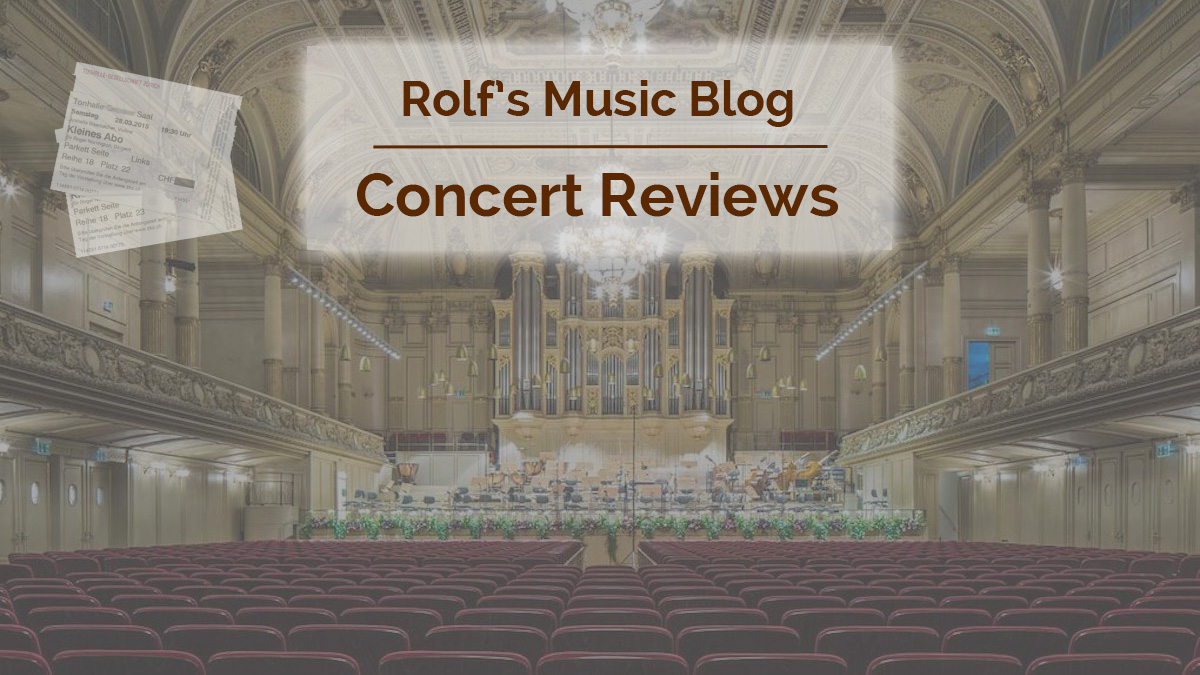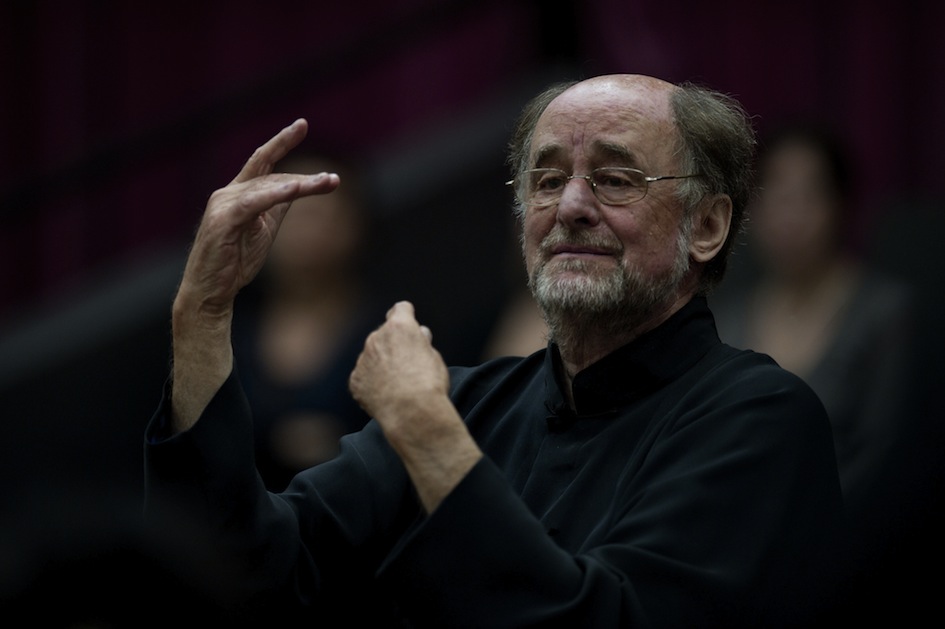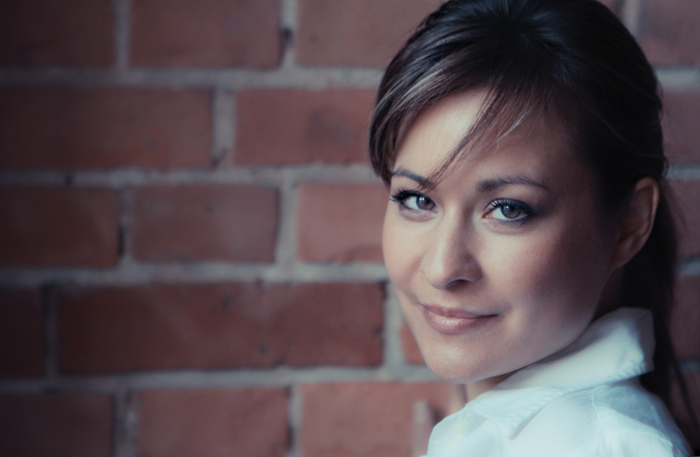Sir Roger Norrington & Arabella Steinbacher
With the Zurich Chamber Orchestra
Tonhalle Zurich, 2015-03-28

2015-04-02 — Original posting
2016-08-04 — Brushed up for better readability
Table of Contents
- Introduction
- Program and Review
- Conclusion
- Addendum 1
- Addendum 2
Introduction
This was another Mozart evening with Sir Roger Norrington conducting the Zurich Chamber Orchestra (Zürcher Kammerorchester, ZKO), the fourth one in a series of five concerts this season (see my review for #2 in the same series), each with an early and a late symphony surrounding one of Mozart’s concerts. It is a pity to read in the media that this apparently is Sir Roger’s last season as principal conductor of the ZKO. But then, he turned 81 this march and deserves a rest, or at least working at a slower pace, with fewer firm commitments.
Program and Review
Wolfgang Amadeus Mozart (1756 – 1791): Symphony No.5 in B major, K.22
As already in previous concerts, the evening started with an early symphony. This time it was Symphony No.5 in B major, K.22, written 1765, when the composer was just 9 years old. The numbering isn’t Mozart’s. It’s actually incorrect, as the symphonies No.2 and 3 are apparently not authentic. In a preceding concert, K.19 (Symphony “No.4” in D, really Mozart’s second symphony) was around 9 minutes. This time, the introduction with the “fifth” symphony, K.22, was even shorter, a mere 6 minutes. This really is the work of a boy who is trying out composing a symphony. The composition features just three, very short movements. It is merely alluding to classical form principles, such as a sonata form.
Mozart had yet to learn inventing real, compelling melodies, let alone complex themes. He mostly worked with short motifs / melodic fragments. And he added bits and pieces that he picked up from other composers of the time. He certainly knew what is effective with the audiences. Inevitably, a few bars into the first movement, there’s a “Mannheim Crescendo”. The “Mannheim Rocket”, as some people called it, is a “hit feature” invented by composers of the Mannheim School, for their local orchestra, one of the best ensembles of its time. While traveling extensively with his father, Mozart met this orchestra. He instantly must have realized the virtuosity of these musicians. Such encounters explain why even Mozart’s early symphonies are already rather demanding for the musicians, requiring a fair amount of virtuosity and good coordination.
The Performance
In Mozart’s time, these symphonies were “conducted” from the harpsichord. Here, Sir Roger Norrington conducted with minimal gestures, merely setting accents, indicating key phrases. He essentially left the coordination in the hands of the concert master, Willi Zimmermann.
Norrington’s fast tempo in the outer movements did not really challenge orchestra. The interpretation remained transparent, light, with clear contrasts. At the same time, it featured a mellow, never aggressive overall sound. The balance (e.g., between wind instruments and strings) was excellent.
One could argue that the addition of a harpsichord, the use of natural horns and period woodwinds would have been historically “more informed”. In other words: it would better show how the symphony must have sounded at Mozart’s time. On the other hand, the venue was certainly bigger than what Mozart had in mind in his early years. Even with modern wind instruments, the music was at the limit of being “too small” for the Tonhalle-Saal with its 1500 seats. Such a chamber symphony (especially if period instruments were used) is really suited (and written) for smaller venues.
Mozart: Violin Concerto in A major, K.219
After this short introduction / symphony / overture, Arabella Steinbacher (born 1981 in Munich) was the soloist in Mozart’s fifth (and last) Violin Concerto in A major, K.219. Arabella Steinbacher has studied with Ana Chumachenco. She received further education through Ivry Gitlis, Dorothy DeLay, Kurt Sassmannshaus and Anne-Sophie Mutter. With that, she is not an exponent of historically informed performance practice (HIP) by education. I was curious to see how and whether shewould adapt her playing to Norrington’s requirements for historically informed performances with very limited, if any vibrato. Or rather: using vibrato as an ornament only, rather than virtually all the time. Permanent vibrato became a common practice in the first half of the 20th century only.
The concerto in A major, K.219 (written 1775, at the age of 19) is sometimes called “Turkish”. It’s a concerto that people are almost too familiar with, maybe?
I. Allegro aperto
As one could expect after the fast movements in the first symphony, the orchestral introduction to the concerto (Allegro aperto) started in a rather fresh / refreshing tempo: a promising beginning! But unexpectedly (to the novice listener), the introduction ends in a fermata, and Mozart introduces the solo instrument in an Adagio, totally alone for a short moment. That’s a difficult, maybe shaky moment for soloists, in which they must adjust to the acoustics of the venue (sound and reverberation may be entirely different when the hall is empty in rehearsals). Questions such as “how much bow do I need to make the violin sound?” or “How’s the balance with the orchestra?” must be resolved in an instant.
Mozart appeared not to offer an opportunity to “grow out of the orchestra” gradually. On the other hand, the score indicates that Mozart assumed that the principal violinist (concert master) would take the solo part, so the soloist would play the introduction colla parte. Here, Arabella Steinbacher only started with the first solo. That is a soft crescendo, and the soloist fiercely started without vibrato. Maybe she wasn’t convinced about the result? In any case, she soon switched to a slow, rather heavy vibrato. Later she gradually turned towards her personal style, with a vibrato that was fairly ubiquitous, but actually not excessive or irritating. Sir Roger Norrington may have preferred differently, but overall, I think this was the best and most convincing solution.
Arabella Steinbacher played with firm intonation, with rather soft tone and articulation. Like the majority of violinists, she could not resist the natural fit and beauty of Joseph Joachim’s cadenzas for this concert. They are indeed an excellent fit to Mozart’s music.
II. Adagio
The slow movement (Adagio) is often “celebrated” at an almost unbearably slow pace. I was pleased to hear a refreshing tempo here. Clearly, Norrington observes the 2/4 notation, hence taking the Adagio with two beats per bar, which makes a lot of sense to me. The movement was further condensed because Arabella Steinbacher left out the first half of Joachim’s cadenza.
III. Tempo di Menuetto — Allegro
In the aftermath, there was additional justification for streamlining the slow movement: Norrington took the Tempo di Menuetto as “fairly slow”. That is “the way people were dancing to this music”, as he explained after the intermission. So, contrary to my first impression, it was not the soloist who set the pace at the transition to the last movement. But frankly, to me, the movement started to suffer from “lengths” at this pace. In addition, that slow tempo was not sustainable. So, the minore section was noticeably faster. This, I think, is hardly justifiable from the score.
Luckily, Mozart inserted a little (and very welcome) surprise in the center of the movement, a “Turkish” Allegro episode (hence the popular nickname for this concerto), evoking pictures of a Turkish marching band: Prince Eugene‘s victory over the Turks in the Austro-Turkish War of 1716–18 obviously was an immensely popular topos in Austria throughout that century! The projection of Arabella Steinbacher’s Stradivarius appeared somewhat limited at times. But this could also be related to the fact that for this composition and this orchestra size the venue was somewhat big.
Encore — Eugène Ysaÿe (1858 – 1931): Obsession from Violin Sonata No.2 in A minor, op.27/2
As encore, Arabella Steinbacher played the first movement, Obsession, from Eugène Ysaÿe’s second violin sonata in A minor (op.27/2). She played it almost with the soft- and smoothness of the Mozart concerto. The acoustics of the venue may have contributed to this impression. My preference would have been a tone with more grip for this piece: maybe not where it quotes the Preludio from Bach’s Partita No.3 in E major (BWV 1006), but definitely in the “true Ysaÿe sections”.
Mozart: Symphony No.41 in C major, K.551, “Jupiter”
No doubt: the culmination of the evening was Mozart’s Symphony No.41 in C major, K.551, known as “Jupiter“. This is Mozart’s last symphony, written 1788. It was a true highlight not just because of Sir Roger Norrington’s interpretation, but also thanks to the transparency and agility of the orchestra, its perfect acoustic balance, both in sound, as well as spatially. It seemed an ideal orchestral arrangement to have the violin voices facing each other. The bassoons on the right were counterbalancing the cellos in the rear left side. The trumpets (between bassoons and the timpani) counterbalanced the horns on the left. Flute and oboes were standing at the left edge, facing the orchestra, hence ideally mixing with the strings. The additional wind instruments in this symphony also provided extra volume, more adequate for a venue with 1500 seats.
I. Allegro vivace
Right from the beginning of the first movement (Allegro vivace) one could sense and enjoy Norrington’s very detailed dynamics, the clear contrasts, very careful phrasing and articulation, down to individual ornaments — and the joyful playing in general.
II. Andante cantabile
Also here, the orchestra did not celebrate the second movement: it played with clear contrasts, and at a pace that seemed unusually “fast”. But that tempo is perfectly adequate for the annotation Andante cantabile. Sir Roger Norrington emphasized the tragic aspects of this movement. In his short introduction after the intermission, he explicitly mentioned the movement’s relationship with Don Giovanni. Indeed, one felt thrown back into the darkness of the Symphony No.40 in G minor.
III. Menuet: Allegretto
Different from the violin concerto, the Menuet in this symphony bears the annotation Allegretto. Therefore, Norrington selected a refreshing tempo, with clear contrasts in the sforzati.
IV. Finale: Molto allegro
Sir Roger Norrington introduced the last movement (Finale: Molto allegro) as being the most complex among all symphony movements from the Vienna Classic period: a sonata movement, mostly fugato, with “up to seven themes” playing concurrently, in which Mozart (according to Norrington) “wanted to prove how clever he is”. Unusually, Mozart explicitly (and purposefully) writes repeat signs around the second part (development and recapitulation), which the conductor of course observed.
This could make up for a very long movement. But Sir Roger Norrington once more selected a tempo that is substantially faster than with conventional interpretations. This made the movement dramatic rather than just “big”, and it helped the listener in following the overall structure of this Finale. At the same time, it avoided any “lengths”. Quite to the contrary: this fascinating, often almost overwhelming music enthralled, moved everybody in the audience.
Conclusion
It was a fascinating concert experience, and a strong, very convincing, compelling interpretation, both on the part of the conductor as well as the orchestra!
Addendum 1
For the same concert, I have also written a (much shorter) review in German for Bachtrack.com. This posting is not a translation of that German review, the rights of which remain with Bachtrack. I create the German review using a subset of the notes taken during this concert. I wanted to enable my non-German speaking readers to read about my concert experience as well. Therefore, I have taken my original notes as a loose basis for this separate posting. I’m including additional material that is not present in the Bachtrack review.
Addendum 2
For some of the works (all by Mozart) in this concert I have written separate CD reviews with more in-depth coverage of the composition:
- Symphony in A major, K.22
- Violin Concerto No.5 in A major, K.219
- Symphony in C major, K.551, “Jupiter”



